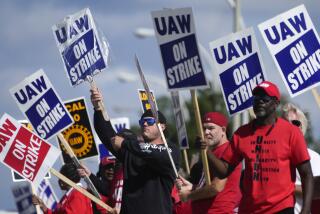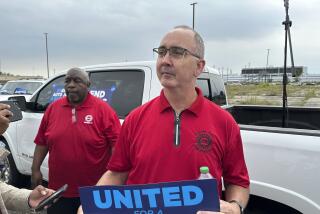Greyhound May Go Way of Eastern : Labor: Financial collapse and hope of a better deal from a new bus company owner could be strategy if strike takes path of the troubled airline.
- Share via
After five weeks, the Greyhound bus strike has become a war of attrition that may eventually resemble the Eastern Airlines strike, where workers virtually gave up any short-term hope of getting their jobs back and aimed instead for the financial destruction of their company.
In such a scenario, Greyhound would operate indefinitely as a shrunken, non-union company using permanently hired replacement workers. Strikers would literally wait on the sidelines, hoping the company would falter, file for bankruptcy protection and eventually fall into the hands of a new owner who might cut a better deal with the union.
When the strike by 6,000 drivers and 3,000 clerical and maintenance employees first began March 2, strikers were cheered by how few buses Greyhound was able to put on the road.
But now that Greyhound claims to be running nearly 50% of its regular departure load, as opposed to about 20% during the strike’s first week, strikers are pointing with satisfaction to a recent financial statement by Greyhound that acknowledged the work stoppage could be costly.
In its annual financial report filed with the Securities and Exchange Commission, Greyhound said: “There is some risk that a prolonged strike would seriously impair the company’s financial position and future operations.”
The report also said Greyhound has borrowed $25 million since the strike began, discussed renegotiating other loans and cut capital spending plans by 20% through next year. The report also said the long-term profitability of Greyhound’s package express business has been affected.
Greyhound also has failed by a wide margin to meet its initial goal of having 80% of its service in operation by the end of March. Only 48.7% of its routes were served Thursday.
However, “there is no truth to the notion we are in financial trouble,” a Greyhound spokesman said last week.
Meanwhile, the prospect of further negotiations between Greyhound and the Amalgamated Council of Greyhound Locals has diminished as relations between the strikers and the bus company deteriorated into bombastic exchanges.
Last week, Greyhound Chairman Fred Currey, alluding to a continuing string of sniper fire at Greyhound buses, said “no American worth his salt negotiates with terrorists.” Edward Strait, president of the council, responded that the company’s refusal to return to the bargaining table was “putting the negotiations back into the hands of terrorists.” The union, contending that it has no control over individual acts, has accused Greyhound of using the shootings as an excuse to avoid negotiating.
Greyhound began last week by demanding seven days without an attack on a bus as a precondition of resuming negotiations. By the week’s end, the company was saying it might drop that demand if the union took disciplinary action against members who had committed violence. A Greyhound spokesman said Friday that the company is in the process of firing 60 non-striking employees who it believes have committed violence.
At issue in the strike is the drivers’ demand for an increase in the 30-cents-per-mile wage. The drivers want a flat increase. Greyhound wants to condition an increase on company profitability. The company refuses to agree to a contract that would increase fares, arguing that such a move would cut ridership.
Most striking drivers long ago began working other jobs and union officials acknowledge that even if the strike is settled, many of those who had been with Greyhound only a few years probably would not return. Strikers with the biggest stake in the outcome are older drivers hired before 1983, when pension benefits were far better.
Jim Cushing-Murray, the president of the Los Angeles Greyhound drivers’ local who said he had argued against a strike, said he believes that Greyhound probably can no longer afford a pay raise that would satisfy strikers because it has lost so much money from the work stoppage. Workers had agreed to pay cuts of 8% and 23% in their last two contracts.
“I don’t think there’s any victory we can get out of this now,” he said. “The only hope for the union is that Currey goes bankrupt and the union is able to purchase Greyhound” by using the financial leverage of employee-owned stock and financing from a friendly financial institution.
The International Assn. of Machinists pursued much the same strategy after it went on strike against Eastern Airlines a year ago. Eastern subsequently sustained massive financial losses as it continued to operate and sought protection from creditors in bankruptcy court. The airline’s creditors, exasperated by Eastern’s mounting losses, voted last week to reject the airline’s latest reorganization proposal and asked the court to appoint a special trustee to sell Eastern.
“If (Greyhound Chairman Currey has) spent as much as we think, he doesn’t have any more money to pay wages. He’s destroyed the creditability of the company’s package express business. He’s destroyed his summer charter business. He’s at least destroyed the business for one year,” Cushing-Murray said.
Currey purchased Greyhound in 1987 when it was heavily in the red and finally turned a small profit of $700,000 on revenues of $1 billion last year. The company actually made a $49-million operating profit, but it was wiped out by interest payments on loans Currey assumed to purchase the company.
In some quarters of organized labor, the Greyhound strike has been regarded as a no-win effort from the moment drivers walked off. Critics say the strike was called without sufficient preparation and that it would have been strategically smarter for drivers to have continued negotiating and working without a contract. Striking, these critics say, merely triggered what has become a familiar management response in American industrial relations: hiring replacements, continuing to operate, cutting off negotiations and, in effect, freezing the strikers out.
“It was just a suicide mission,” one labor union consultant said. “Then the guys are all frustrated, feeling a lot of pain, so they’re sitting on the side of the road taking shots.”
More to Read
Inside the business of entertainment
The Wide Shot brings you news, analysis and insights on everything from streaming wars to production — and what it all means for the future.
You may occasionally receive promotional content from the Los Angeles Times.










